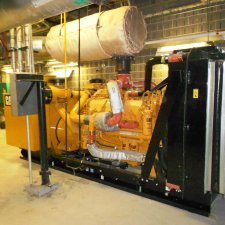Erie County Medical Center
Utility Infrastructure Expansion Planning & Design
Buffalo, NY
Healthcare Engineering - Project Highlights
Chilled Water System
The existing 4800 ton chiller plant was upgraded and updated by the addition of two (2) new 2400 ton chillers for a total new capacity of 7200 tons. Primary and secondary chilled water pumps were replaced and the pumping system was converted to a variable flow system. The control system for the entire chilled water plant, including condenser water pumps and cooling towers was also updated to include a demand flow plant optimization control sequence.
The approximate construction cost for the complete chiller plant project is $6,750,000.
Energy conservation incentives by NYSERDA are expected to be approximately $1,200,000.
The measures implemented will result in 3,200,000 kWH/Yr. ($170,000/Yr.) and 1,090 kW demand reductions.
Condenser Water System
The existing condenser water system consisting of six (6) condenser water pumps, and six (6) cooling towers was replaced with four (4) new variable speed condenser water pumps and nine (9) new variable speed/variable flow cooling towers. The pumps and towers are integrated with the demand flow chiller plant controls strategy to provide maximum energy efficiency. The pumps and towers utilize a common header system to maximize the redundancy and flexibility of operation.
High Pressure Steam System
It was determined that the existing steam boiler plant, consisting of three (3) 80,000 lb./hr. water tube boilers, has adequate capacity and redundancy for the planned expansion. Burner and control upgrades may be considered in the future.
The existing steam system was extended to serve the new buildings via an 8 inch high pressure (120 psi) steam line, reduced in two stages to 50 psi medium pressure steam and ultimately to 15 psi low pressure steam at the building.
Electrical Engineering Services
The existing 23 kV 9MW 40-year old electrical service was replaced with a new 23 kV 15MW Electrical Substation that provides the additional capacity for today and tomorrow's facilities and enhanced controls and protection. The new substation provides improved redundancy and automatic contingency for a loss of one (1) of the four (4) National Grid lines. The electrical substation was replaced sequentially using adjacent land for the new substation without any major interruptions to the Hospital.
The approximate construction cost is $3,000,000.
Emergency Power
Five (5) new generators were provided to campus. Two (2) 800 kW paralleled generators replace two (2) existing paralleled generators in the existing Hospital tower; the existing generators were 30+ years old with growing concerns regarding redundancy and capacity. A new generator farm with three (3) 750 kW generators are connected in parallel. The new generator serves the North end of the campus.
The approximate construction cost is $600,000.
Domestic Water Systems
The existing domestic water systems were extended from the
Main Building to the Renal Dialysis/Medical Office Building (MOB) and Behavioral Health Building Additions.
A new domestic water service was provided for the Skilled Nursing Facility Building, including backflow preventers and pressure booster pumps.
Fire Protection Water Service
The existing fire protection water service was extended from the existing fire pump in the Main Building to the Renal Dialysis/Medical Office Building (MOB) and Behavioral Health Building Additions. A new fire protection water service was provided for the Skilled Nursing Facility Building, including backflow preventers and electric fire pump.
Bulk Oxygen System
The existing bulk oxygen system was upgraded to provide additional capacity for the planned expansion and new Hyperbaric Chambers.
Medical Gases
Existing oxygen, medical air and medical vacuum were extended from the Main Building to the Renal Dialysis/Medical Office Building (MOB) and Behavioral Building Additions. Existing oxygen was extended to the Skilled Nursing Facility Building. New medical air and medical vacuum systems were provided at the Skilled Nursing Facility Building.
All of the upgrades noted above were implemented to accommodate increased load, end of life replacement, increased efficiency, added redundancy and reliability and future flexibility.





